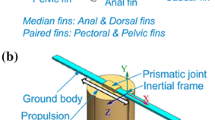Abstract
A comprehensive numerical simulation of the hydrodynamic performance of a caudal fin with unsymmetric flapping motion is carried out. The unsymmetrical motion is induced by adding a pitch bias or a heave bias. A numerical simulation program based on the unsteady panel method is developed to simulate the hydrodynamics of an unsymmetrical flapping caudal fin. ACFD code based on Navier-Stokes equations is used to analyze the flow field. Computational results of both the panel method and the CFD method indicate that the hydrodynamics are greatly affected by the pitch bias and the heave bias. The mean lateral force coefficient is not zero as in contrast with the symmetrical flapping motion. By increasing the pitch bias angle, the mean thrust force coefficient is reduced rapidly. By adding a heave bias, the hydrodynamic coefficients are separated as two parts: in one part, the amplitude is the heave amplitude plus the bias and in the other part, it is the heave amplitude minus the bias. Analysis of the flow field shows that the vortex distribution is not symmetrical, which generates the non-zero mean lateral force coefficient.
Similar content being viewed by others
References
FISH F. E., LAUDER G. V. Passive and active flow control by swimming fishes and mammals[J]. Annual Review Fluid Mechanics, 2006, 38: 193–224.
LI Long, YIN Xie-zhen. Experiments on propulsive characteristics of the caudal-fin models of carangiform fish in cruise[J]. Journal of Experiments in Fluid Mechanics, 2008, 22(1): 1–6(in Chinese).
LAUDER G. V., DRUCKER E. G. Morphology and experimental hydrodynamics of fish fin control surfaces[J]. Ieee Journal of Oceanic Engineering, 2004, 29(3): 556–571.
READ D. A., HOVER F. S. and TRIANTAFYLLOU M. S. Forces on oscillating foils for propulsion and maneuvering[J]. Journal of Fluids and Structures, 2003, 17(1): 163–183.
SCHOUVEILER L., HOVER F. S. and TRIANTAFYLLOU M. S. Performance of flapping foil propulsion[J]. Journal of Fluids and Structures, 2005, 20(7): 949–959.
LIU Zhen, HYUN Beom-soo and KIM Moo-rong et al. Experimental and numerical study for hydrodynamic characteristics of an oscillating hydrofoil[J]. Journal of Hydrodynamics, 2008, 20(3): 280–287.
YAN Hui, SU Yu-min and YANG Liang. Experimentation of fish swimming based on tracking locomotion locus[J]. Journal of Bionic Engineering, 2008, 5(3): 258–263.
SONG Hong-jun, WANG Zhao and YIN Xie-zhen. Numerical simulation on unsteady motion of 2D air-foil[J]. Journal of Hydrodynamics, Ser. A, 2004, 19(Suppl): 896–903(in Chinese).
YANG Liang, SU Yu-min. Hydrodynamic analysis of an oscillating tail-fin in viscous flows[J]. Journal of Harbin Engineering University, 2007, 28(10): 1073–1078(in Chinese).
HOVER F S, HAUGSDAL Φ. and TRIANTAFYLLOU M. S. Effect of angle of attack profiles in flapping foil propulsion[J]. Journal of Fluids and Structures, 2004, 19(1): 37–47.
KATZ J., WEIHS D. Wake rollup and the kutta condition for airfoils oscillating at high frequency[J]. Aiaa Journal, 1981, 19(12): 1604–6
SU Yu-min, HUANG Sheng et al. Hydrodynamic analysis of submersible propulsion system imitating tuna-tail[J]. The Ocean Engineering, 2002, 20(2): 54–59(in Chinese).
GUO Zheng, LIU Jun and QU Zhang-hua. Simulation of oscillating airfoil flow using dynamic unstructured grids[C]. Proceedings of 4th Asian Computational Fluid Dynamics Conference. Mianyang, 2000, 238–243.
WANG Zhao-li, SU Yu-min and YANG Liang. Hydro-dynamic analysis of the pectoral-fins in viscous flows[J]. Chinese Journal of Hydrodynamics, 2009, 24(2): 141–149(in Chinese).
ZHANG Xi, SU Yu-min and WANG Zhao-li. Numerical and experimental studies of influence of the caudal fin shape on the propulsion performance of a flapping caudal fin[J]. Journal of Hydrodynamics, 2011, 23(3): 325–332.
WANG Zhi-dong, LAO Yi-jia and LI Li-jun et al. Experiment on the characteristic of 3-D vortex ring behind a flexible oscillating caudal fin[J]. Journal of Hydrodynamics, 2010, 22(3): 393–401.
Author information
Authors and Affiliations
Corresponding author
Additional information
Project supported by the National Nature Science Foundation of China (Grant No. 50879014), the Doctoral Program of Higher Education of China (Grant No. 200802170010).
Biography: ZHANG Xi (1985-), Male, Ph. D. Candidate
Rights and permissions
About this article
Cite this article
Zhang, X., Su, Ym. & Wang, Zl. Numerical Simulation of the Hydrodynamic Performance of An Unsymmetrical Flapping Caudal Fin. J Hydrodyn 24, 354–362 (2012). https://doi.org/10.1016/S1001-6058(11)60255-2
Received:
Revised:
Published:
Issue Date:
DOI: https://doi.org/10.1016/S1001-6058(11)60255-2




